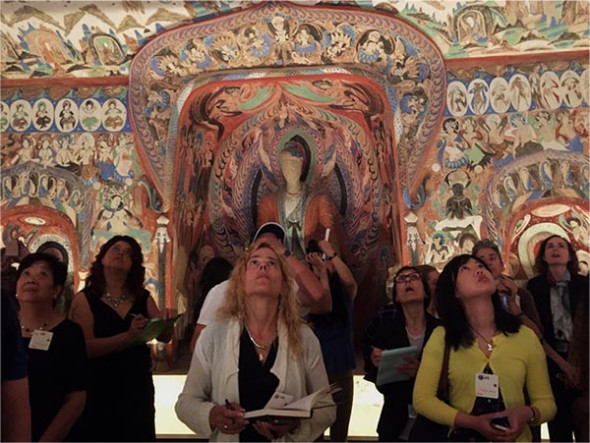
American K-12 teachers visit an exhibition about Dunhuang at the Getty Center in Los Angeles, in a summer public program by UCLA Confucius Institute in 2016. (Photo provided to China Daily)
Dunhuang, located on the edge of the Gobi Desert in Gansu province, was once a bustling oasis on the ancient Silk Road. Today it is famous for the Mogao Grottoes, one of the world's largest sites of Buddhist art.
In the eyes of Susan Pertel Jain, director of the Confucius Institute at the University of California, Los Angeles, Dunhuang was once "a cultural crossroads where people speaking different languages, holding different values and belief systems met, interacted and achieved something amazing that can still inspire us today" .
"Since the late 4th through the 14th centuries, artists from all over made artworks here," she says. "It is a place of tolerance and collaboration."
With this in mind, Jain's team has developed programs exploring different aspects of the art of the grottoes.
Last year, the Getty Center in Los Angeles held a four-month exhibition of Dunhuang art titled Cave Temples of Dunhuang: Buddhist Art on China's Silk Road. It featured models of the caves from China, along with paintings and manuscripts taken from Dunhuang in the early 20th century and held by British and French libraries and museums.
The exhibition was to celebrate the 25th year of collaboration between the J. Paul Getty Museum and Dunhuang Academy in the conservation of the cave art and preservation of the site.
Before the exhibition, the UCLA Confucius Institute was asked by the Getty Center to create public programs that would expand people's understanding of Dunhuang in collaboration with Peter Sellars, a professor at UCLA and a theater director in the United States.
Jain's team also hosted an exhibition-related concert titled East and West of Dunhuang: Music Carried on the Wind in May 2016.
Master musicians and scholar-performers of UCLA from China, India, the Middle East and Central Asia brought the ancient exchanges to life by presenting music from their own cultures.
"People may never have heard the types of music depicted in the artworks before, but the concert showed us how things happened in ancient times," Jain says.
Which in these ritual spaces, as Sellars once said, was the stimulation of all the senses.


















































